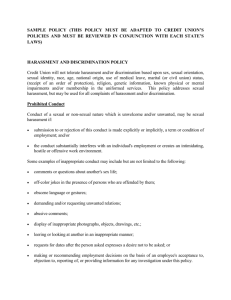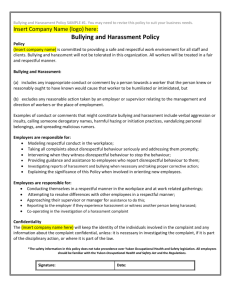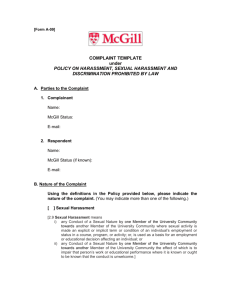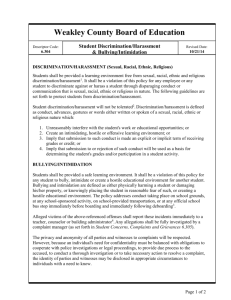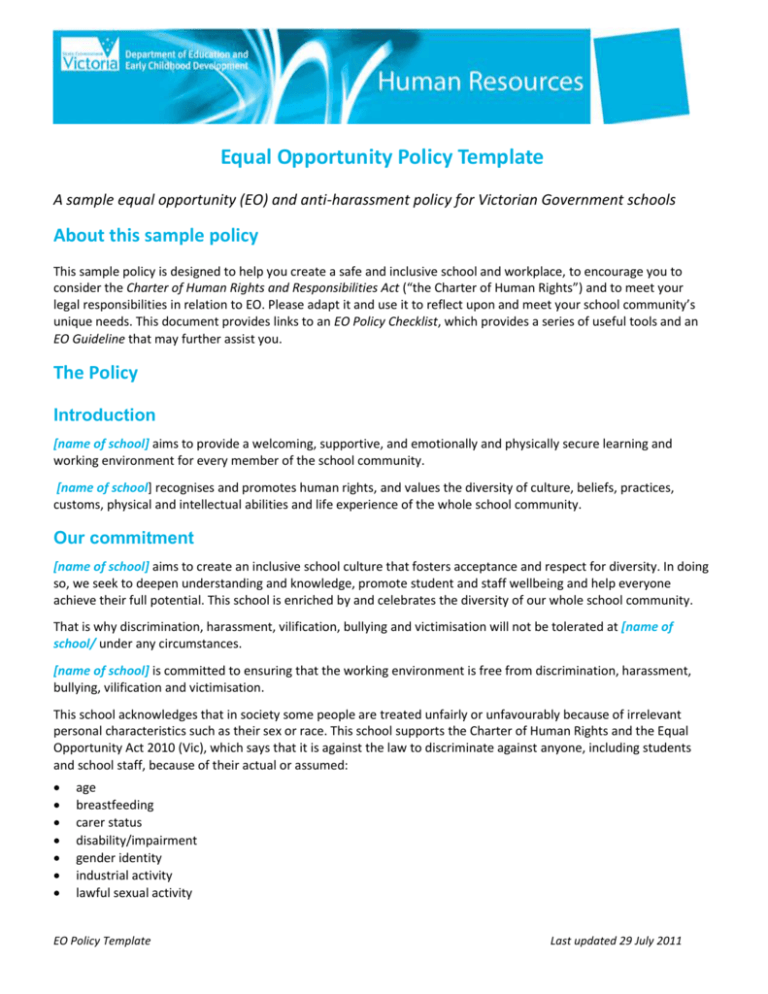
Equal Opportunity Policy Template
A sample equal opportunity (EO) and anti-harassment policy for Victorian Government schools
About this sample policy
This sample policy is designed to help you create a safe and inclusive school and workplace, to encourage you to
consider the Charter of Human Rights and Responsibilities Act (“the Charter of Human Rights”) and to meet your
legal responsibilities in relation to EO. Please adapt it and use it to reflect upon and meet your school community’s
unique needs. This document provides links to an EO Policy Checklist, which provides a series of useful tools and an
EO Guideline that may further assist you.
The Policy
Introduction
[name of school] aims to provide a welcoming, supportive, and emotionally and physically secure learning and
working environment for every member of the school community.
[name of school] recognises and promotes human rights, and values the diversity of culture, beliefs, practices,
customs, physical and intellectual abilities and life experience of the whole school community.
Our commitment
[name of school] aims to create an inclusive school culture that fosters acceptance and respect for diversity. In doing
so, we seek to deepen understanding and knowledge, promote student and staff wellbeing and help everyone
achieve their full potential. This school is enriched by and celebrates the diversity of our whole school community.
That is why discrimination, harassment, vilification, bullying and victimisation will not be tolerated at [name of
school/ under any circumstances.
[name of school] is committed to ensuring that the working environment is free from discrimination, harassment,
bullying, vilification and victimisation.
This school acknowledges that in society some people are treated unfairly or unfavourably because of irrelevant
personal characteristics such as their sex or race. This school supports the Charter of Human Rights and the Equal
Opportunity Act 2010 (Vic), which says that it is against the law to discriminate against anyone, including students
and school staff, because of their actual or assumed:
age
breastfeeding
carer status
disability/impairment
gender identity
industrial activity
lawful sexual activity
EO Policy Template
Last updated 29 July 2011
marital status
parental status
physical features
political belief or activity
pregnancy
race
religious belief or activity
sex
sexual orientation
personal association with someone who has, or is assumed to have, one of these personal
characteristics.
No member of the school community will be treated less favourably because they possess any of these personal
characteristics nor will such characteristics affect access to benefits and services [name of school] provides.
On behalf of the whole school community, the principal, the school council president, the parent association and the
student representative council support this policy, and the human rights principles and practice of equal opportunity,
inclusion and respect for diversity that it articulates.
Discrimination is unacceptable at [name of school]
Discrimination may be direct or indirect – both are against the law.
Direct discrimination means treating someone unfairly or less favourably because of one of the personal
characteristics listed above or because of their association with someone identified with one of those characteristics.
Examples: refusing to enroll a student because he has Hepatitis C, refusing to allow a Muslim student to wear
the hijab as part of her school uniform or failing to hire a suitably qualified teacher because of his or her sexual
orientation.
Indirect discrimination happens when a rule, policy or requirement unnecessarily or unreasonably disadvantages a
person or group of people because of a protected personal characteristic they share.
Example: Imposing a requirement that all students take notes from the whiteboard without assistance may
unreasonably disadvantage a student with vision impairment. .
Harassment is unacceptable at [name of school]
Harassment is behaviour (through words or actions) based on the personal characteristics listed above that are
unwanted, unasked for, unreturned and likely to make school an unfriendly or uncomfortable place by:
humiliating (putting someone down)
seriously embarrassing
offending (hurting someone’s feelings) or
intimidating (threatening someone so they behave in a certain way).
Examples: name calling, stereotyping jokes and offensive comments.
EO Policy Template
Last updated 29 July 2011
Sexual harassment is an unwelcome sexual advance; request for sex or any other sexual behaviour that a reasonable
person would know or expect would offend, humiliate, seriously embarrass or humiliate another.
Examples: unwanted touching, unwelcome sexual innuendo or jokes, displaying sexually explicit material
(posters, emails, internet sites).
Racial and religious vilification is unacceptable at [name of school]
Vilification is behaviour (through words or actions) that incites hatred, serious contempt or ridicule of another
person or group of people because of their race or religious belief.
Examples: public threats of harm, encouraging others to hate someone because of their religion, racist statements
made in a public meeting, racist graffiti
Bullying is unacceptable at [name of school]
Bullying is unreasonable behaviour that is intimidating, threatening or humiliating and repeated over time or
occurring as part of a pattern of behaviour. Bullying can be physical, verbal or indirect, and creates an unfriendly,
threatening or offensive environment.
Examples: taking or damaging other people’s property, excluding or isolating someone, subjecting someone to
homophobic abuse, deliberately withholding information so as to affect their work performance, threatening
not to renew an employment contract.
Victimising someone who makes an EO complaint is unacceptable at [name of school]
Victimisation means treating someone unfairly or otherwise disadvantaging them because they have made an EO
complaint or might do so in the future.
[name of school] will take action to prevent discrimination, harassment, vilification, bullying and victimisation and to
promote a safe and inclusive school.
[name of school] will take immediate and appropriate action to address and resolve EO issues and complaints.
[name of school] will take action to promote human rights both in terms of school policy and practice and within its
educational activities and culture.
A human rights based approach means taking steps to assess the school’s decisions and actions within the
framework of the Charter and also taking proactive steps to encourage and promote wider school discussion and
student learning on the key Charter themes of Freedom, Respect, Equality and Dignity.
Who and what this policy covers
This policy covers the whole school community, including staff, students, parents, school council members,
contractors and volunteers.
This policy applies to:
education (teaching and learning, enrolment, student management, student services, curriculum
development and delivery)
the provision of goods and services (extracurricular activities, camps, parent–teacher interviews, access
to facilities)
school sport
EO Policy Template
Last updated 29 July 2011
employment at the school (recruitment, allocation of duties, employment conditions, access to benefits
such as training, promotion and leave).
Policy framework and relevant information
[name of school] EO policy is one component of the Department’s broader policy framework for the promotion of
safe and inclusive schools and protection of human rights.
Other relevant policy may include:
Managing Diversity and Inclusive Workplaces
Equal opportunity, Discrimination and Harassment
Complaint Resolution Procedures
Health, Safety and WorkSafe
Building Respectful and Safe Schools
School codes of conduct
School anti-bullying policy
Charter of Human Rights and Responsibilities Act 2006 including any relevant Department policies
Rights and Responsibilities
Under this policy, every member of the [name of school] has the right to learn and work in a safe and inclusive
environment free of discrimination, harassment, bullying, vilification and victimisation. Along with this right comes
the responsibility to respect and promote human rights and responsibilities by behaving according to this policy.
The principal of [name of school] is accountable for implementation of this policy.
The principal of [name of school] may appoint an EO and Anti-Harassment Co-ordinator to support implementation
of this policy.
This policy will be reviewed regularly by [insert name and position e.g. the principal, assistant principal, Equal
Opportunity Co-ordinator or sub-committee of School Council] and ratified by the school council.
Complaints procedures
The [name of school] encourages all members of the school community to attempt to resolve complaints and
concerns through the school.
All complaints will be treated confidentially, fairly and consistently, and resolved as speedily as possible.
Any member of the school community who raises an issue of discrimination, harassment, bullying or vilification in
good faith will not be victimised or otherwise unfairly treated or disadvantaged. All complaints of victimisation will
be taken seriously, investigated and acted upon as quickly as possible.
Every student and staff member at [name of school] should feel welcome, supported and emotionally and physically
secure at school. The wellbeing of all students and staff is a priority for [name of school.] We understand that you
cannot achieve your potential if someone is treating you unfairly, discriminating against you, vilifying, harassing or
victimising you.
EO Policy Template
Last updated 29 July 2011
Complaints procedures exist to provide an avenue to address unacceptable behaviour. Complaints procedures are
designed to explain what to do if you believe you have been discriminated against, harassed, sexually harassed,
bullied, vilified or victimised as explained earlier in this policy and your complaint is about your education or
employment at [name of school] or goods, services or sport provided by [name of school]
If you are a member of staff:
Please refer to the Department’s Guidelines for Managing Complaints, Unsatisfactory Performance and Misconduct
guidelines.
If you are a parent or guardian:
Please refer to DEECD’s Parent Complaints guidelines.
If you are a student:
You have the right to be part of a safe and inclusive school that is free of discrimination, harassment, sexual
harassment, bullying, vilification and victimisation. This includes treating you unfairly, excluding you or making you
feel bad because of your:
sex
race
sexual orientation
physical features
religious belief or activity
carer status
disability/impairment
gender identity
lawful sexual activity
political belief or activity
pregnancy
personal association with someone who has, or is assumed to have, one of these personal
characteristics.
If you believe someone is discriminating, harassing, bullying, vilifying or victimising you and it is safe for you to do so,
tell the other person to stop their behaviour. Let them know that their behaviour offends you. They may not realise
this.
If the behaviour doesn’t stop or you are not sure what to do, report it to a trusted adult, such as a teacher, the year
level co-ordinator, the principal or the Student Welfare Coordinator. Remember, you are not alone. If you have a
problem or complaint, talking to someone, especially your parents can help. If you do not want to talk to anyone
about it, you can find more information at (insert appropriate electronic links and other relevant contacts, for
example, the Kids Help Line, telephone 1800 55 1800).
If the unfair treatment or harassment persists, you can call the Commission for free and confidential advice. Advice
can be given over the phone or in person. If your issue is covered by Equal Opportunity law, the Complaints Officer
will discuss it with you. They will then explain how the Commission can help you and the information you would
need to include in a complaint should you decide to make one.
[name of school] will treat all reports of misconduct fairly, confidentially and quickly. Only people directly involved in
the issue or complaint will be told about it. Each complaint will be investigated to work out whether it is more likely
the behaviour happened than not and, if so, how serious it is. Appropriate action to resolve the problem will be
taken.
EO Policy Template
Last updated 29 July 2011
The principal (or someone else they appoint) has responsibility for investigating complaints of discrimination,
harassment, bullying, vilification and victimisation.
Consequences: If proven, the consequences of such behaviour may include counseling, the removal of privileges; a
parental interview, suspension or expulsion [name of school] will arrange counseling and support, where
appropriate or where requested, for any student who has experienced bullying or harassment. Counseling may also
be provided for a person who has bullied or harassed another.
The school may also need to discuss the incident with parents.
[name of school] will monitor how the complaint was resolved and the wellbeing of those involved. Further action
will be taken if the problem behaviour continues.
[name of school] encourages all members of the school community to attempt to resolve complaints and concerns
through the school if possible. It is also your right to seek help from outside the school. For example, you can contact
the Department’s regional office, the Ombudsman or the Victorian Equal Opportunity and Human Rights Commission
(VEOHRC) for information or advice, or to make a complaint.
Right to appeal/review
If you are unhappy with the decision about your complaint, you may seek a review of the decision in accordance with
departmental procedures.
Where to obtain help and advice
School complaints contact(s)
DEECD contacts including the regional office and Student Wellbeing Branch
VEOHRC contact details
School Council contacts
Parent support contacts
Student contacts [helplines]
Endorsed by School Council and effective as of: (insert date)
EO Policy Template
Last updated 29 July 2011


